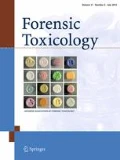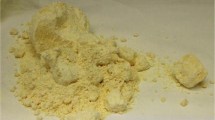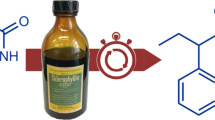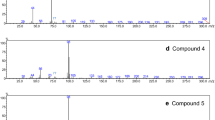Abstract
Purpose
1-Phenyl-2-propanone (P2P) is a main precursor of methamphetamine. The authors investigated the formation of P2P degradation products during long-term storage and the factors that affected P2P degradation.
Methods
Samples of neat P2P, 1 mg/mL P2P in methanol and in ethyl acetate were prepared. These samples were stored at room temperature or 4 °C for 1, 3, and 6 months; then the samples were analyzed by gas chromatography–mass spectrometry. A similar experiment (but stored only for 1 month) was also performed for phenylacetylcarbinol.
Results
Neat P2P stored at room temperature gave degradation products after 3-month storage, and the degradation proceeded over the next 3 months. Benzaldehyde, benzoic acid, benzyl acetate, 1-phenyl-1,2-propanedione, phenylacetylcarbinol, 1-acetoxy-1-phenyl-2-propanone, and 1,1-diphenylacetone were identified as degradation products after 6-month storage. The degradation was prevented incompletely by storage at 4 °C and almost completely by storage in the organic solvents.
Neat phenylacetylcarbinol stored at room temperature was remarkably decomposed. Benzaldehyde, benzoic acid, 1-phenyl-1,2-propanedione, and 1-acetoxy-1-phenyl-2-propanone were regarded as the degradation products. The degradation was prevented incompletely by storage at 4 °C and almost completely by storage in the organic solvents.
Conclusions
These results suggested that P2P and phenylacetylcarbinol were oxidized by oxygen in air and that the organic solvents inhibited the oxidation. P2P was presumed to be initially oxidized to phenylacetylcarbinol, then it was converted to benzaldehyde, benzoic acid, 1-phenyl-1,2-propanedione, and 1-acetoxy-1-phenyl-2-propanone. Production of phenylacetylcarbinol from P2P is useful information for methamphetamine impurity profiling because phenylacetylcarbinol is a precursor of ephedrines, the other methamphetamine precursors.







Similar content being viewed by others
References
Tsujikawa K, Kuwayama K, Miyaguchi H, Kanamori T, Iwata YT, Inoue H (2013) Chemical profiling of seized methamphetamine putatively synthesized from phenylacetic acid derivatives. Forensic Sci Int 227:42–44. https://doi.org/10.1016/j.forsciint.2012.08.036
Toske SG, McConnell JB, Brown JL, Tuten JM, Miller EE, Phillips MZ, Vazquez ER, Lurie IS, Hays PA, Guest EM (2017) Isolation and characterization of a newly identified impurity in methamphetamine synthesized via reductive amination of 1-phenyl-2-propanone (P2P) made from phenylacetic acid/lead (II) acetate. Drug Test Anal 9:453–461. https://doi.org/10.1002/dta.1814
Narita Customs Branch, Tokyo Customs (2020) Law enforcement situation of drug smuggling in Narita International Airport in 2019. https://www.customs.go.jp/tokyo/content/20200212tekihatsujokyo_nrt_drug.pdf. Accessed 27 Aug 2020 (in Japanese)
Drug Enforcement Administration (2020) 2019 National Drug Threat Assessment. https://www.dea.gov/sites/default/files/2020-02/DIR-007-20%202019%20National%20Drug%20Threat%20Assessment%20-%20low%20res210.pdf. Accessed 2 Mar 2020
United Nations Office on Drugs and Crime (2020) World Drug Report 2020, Booklet 3 Drug Supply, pp 42–43, Vienna. https://wdr.unodc.org/wdr2020/field/WDR20_Booklet_3.pdf. Accessed 27 Aug 2020
Merck (2020) Specification sheet of phenylacetone. https://www.sigmaaldrich.com/catalog/DataSheetPage.do?brandKey=SIAL&symbol=55528. Accessed 28 Aug 2020
Cayman Chemical (2020) Shipping and storage information of phenylacetone (exempt preparation), https://www.caymanchem.com/product/16444/phenylacetone-(exempt-preparation). Accessed 12 Mar 2020
Power JD, Kavanagh P, McLaughlin G, Dowling G, Barry M, O’Brien J, Talbot B, Twamley B, Brandt SD (2017) Forensic analysis of P2P derived amphetamine synthesis impurities: identification and characterization of indene by-products. Drug Test Anal 9:446–452. https://doi.org/10.1002/dta.1944
Rani BR, Ubukata M, Osada H (1995) Reduction of arylcarbonyl using zinc dust in acetic acid. Bull Chem Soc Jpn 68:282–284. https://doi.org/10.1246/bcsj.68.282
Lin AF, Miskelly GM (2009) Formation of trifluoroacetylated ephedrine during the analysis of a pseudoephedrine-formaldehyde adduct by TFAA derivatization followed by GC–MS. J Forensic Sci 54:365–369. https://doi.org/10.1111/j.1556-4029.2008.00958.x
Inoue H, Kanamori T, Iwata YT, Ohmae Y, Tsujikawa K, Saitoh S, Kishi T (2003) Methamphetamine impurity profiling using a 0.32 mm i.d. nonpolar capillary column. Forensic Sci Int 135:42–47. https://doi.org/10.1016/s0379-0738(03)00176-2
Armarego WLF (2009) Purification of laboratory chemicals, 6th edn. Butterworth-Heinemann, Oxford
Krawczyk W, Kunda T, Perkowska I, Dudek D (2005) Impurity profiling/comparative analyses of samples of 1-phenyl-2-propanone. Bull Narc 57:33–62 (PMID: 21338015)
Ghosh N, Nayak S, Sahoo AK (2011) Gold-catalyzed regioselective hydration of propargyl acetates assisted by a neighboring carbonyl group: access to α-acyloxy methyl ketones and synthesis of (±)-actinopolymorphol B. J Org Chem 76:500–511. https://doi.org/10.1021/jo101995g
Maroney KAN, Culshhaw PN, Wermuth UD, Cresswell SL (2014) Investigation of the l-phenylacetylcarbinol process to substituted benzaldehydes of interest. Forensic Sci Int 235:52–61. https://doi.org/10.1016/j.forsciint.2013.11.017
Ando T, Akimoto S, Okamoto K, Ikeda Y, Kurashima N (2016) Origin of trace ephedrines contained in P2P-derived methamphetamines—to improve the accuracy of estimating the synthesis route in stimulant profile analysis. Rep Central Customs Lab 56:71–77 (in Japanese)
Qi Y, Evans I, McCluskey A (2007) New impurity profiles of recent Australian imported “ice”: methamphetamine impurity profiling and the identification of (pseudo)ephedrine and Leuckart specific marker compounds. Forensic Sci Int 169:173–180. https://doi.org/10.1016/j.forsciint.2006.08.016
Voroshilova NM, Voroshilov VA, Perkel AL, Freidin BG, Orlova TI (1984) Autooxidation of dibenzyl ketone. Russ J Appl Chem 57:1455–1460 (in Russian)
United Nations International Drug Control Programme (2000) A practical guide to methamphetamine characterization/impurity profiling: method procedures, mass spectral data of selected impurities, and literature references, Vienna. https://www.unodc.org/pdf/scientific/Scitec17%20(with%20spectra).pdf. Accessed 1 Feb 2021
Cox M, Klass G, Koo CWM (2009) Manufacturing by-products from, and stereochemical outcomes of the biotransformation of benzaldehyde used in the synthesis of methamphetamine. Forensic Sci Int 189:60–67. https://doi.org/10.1016/j.forsciint.2009.04.010
Segawa H, Okada Y, Yamamuro T, Kuwayama K, Tsujikawa K, Kanamori T, Iwata YT (2021) Stereoselective analysis of ephedrine and its stereoisomers as impurities and/or by-products in seized methamphetamine by supercritical fluid chromatography/tandem mass spectrometry. Forensic Sci Int 318:110591. https://doi.org/10.1016/j.forsciint.2020.110591
Ende M, Spiteller G (1982) Contaminants in mass spectrometry. Mass Spectr Rev 1:29–62. https://doi.org/10.1002/mas.1280010105
Sato M, Hida M, Nagase H (2004) Analysis of pyrolysis products of methamphetamine. J Anal Toxicol 28:638–643. https://doi.org/10.1093/jat/28.8.638(open access article)
Seelenfreund E, Robinson WA, Amato CM, Tan A-C, Kim J, Robinson SE (2014) Long-term storage of dry versus frozen RNA for next generation molecular studies. PLoS One 9:e111827. https://doi.org/10.1371/journal.pone.0111827(open access article)
World Health Organization (2018) WHO expert committee on drug dependence pre-review: delta-9-tetrahydrocannabinol, section 1: chemistry, Geneve. https://www.who.int/medicines/access/controlled-substances/Section1.THC.Chemistry.pdf?ua=1. Accessed 12 Mar 2020
Acknowledgements
The authors would like to thank Dr. Hajime Miyaguchi of our institute for the kind gift of racemic MA hydrochloride. The authors would like to thank ThinkSCIENCE (https://thinkscience.co.jp/ja/index) for the English language review.
Author information
Authors and Affiliations
Corresponding author
Ethics declarations
Conflict of interest
The authors declare no conflicts of interest associated with this manuscript.
Ethical approval
This article does not contain any studies with human participants or animals performed by any of the authors.
Additional information
Publisher's Note
Springer Nature remains neutral with regard to jurisdictional claims in published maps and institutional affiliations.
Supplementary Information
Below is the link to the electronic supplementary material.
Rights and permissions
About this article
Cite this article
Tsujikawa, K., Okada, Y., Segawa, H. et al. Degradation of 1-phenyl-2-propanone during long-term storage: useful information for methamphetamine impurity profiling. Forensic Toxicol 39, 405–416 (2021). https://doi.org/10.1007/s11419-021-00572-z
Received:
Accepted:
Published:
Issue Date:
DOI: https://doi.org/10.1007/s11419-021-00572-z




